

As a team leader, you already know how to manage your employees and get results. It’s important to grow your team’s skills, but when was the last time you focused on your own skills?
Regularly assessing your strengths and weaknesses will make you a better leader for your team. But you’ll need a solid framework, like the SMART goals method, and an unwavering commitment to personal and professional growth to see real progress.
Check out this guide to see how to make SMART leadership goals work for your career. We’ll even throw in some leadership goal examples and templates to jumpstart your journey to self-improvement.
What Are Leadership Goals?
Leadership goals are specific objectives that anyone in a leadership role sets to improve their effectiveness as a leader. Whether it’s communication skills, team-building efforts, or operations management, these types of goals help with leadership development. 🎉
But not just any goal will do. Goals like “I want to be a better manager” are too flimsy and hard to measure. Use the SMART goal-setting method to set team or personal development goals that push your limits.
All SMART goals are:
- Specific: Define exactly what you want to do. “Be a good leader” is too vague. Go for something specific, like your communication skills, a technical skill, or a specific weakness, like conflict resolution
- Measurable: Every goal needs some kind of quantifiable data to back it up. This is a must-have to help you understand when you’ve achieved a meaningful milestone. For example, “Be a better leader” isn’t quantifiable, but “Boost average team net promoter scores from 6/10 to 9/10” or “Increase team-wide sales by 15%” is way more measurable
- Achievable: Look, there’s nothing wrong with aiming high, but a great leader knows when to be realistic. Set attainable goals. For example, if you want to get a professional certification that takes five months, don’t set a goal to complete it in three months. Unrealistic expectations set you up to fail, so pick goals you can accomplish
- Relevant: A goal like “Be the first to arrive and leave the office every day” is semi-related, but it doesn’t necessarily coincide with your duties as a manager or your leadership style. All SMART goals relate back to your leadership development and role and responsibilities
- Time-bound: It’s easy to drag something out if you don’t have a deadline. All SMART goals need some kind of timeframe to hold you accountable

SMART goals work better than generic leadership goals because they offer a structured template that makes it easier to track your progress and get results. They’re a must for creating effective leadership development goals.
Short-term vs. long-term goals
When setting leadership development goals, we recommend creating a mix of both short-term goals and long-term goals.
Create short-term SMART goals for the next 30 days, like “Act on 80% of employee feedback” or “Dedicate 15 minutes at the beginning of the day for a team huddle.” These goals are usually easier to achieve, but they give you much-needed wins that motivate you to tackle bigger goals.
Long-term goals are also important because they give you something bigger to aim for. That might be “Take on a C-suite role within the next 18 months” or “Reduce team turnover by 30% over the next three years.” You won’t see an immediate payoff, but long-term goals lead to some of the most impressive changes over time.
If your long-term goals seem too big, chop them up into short-term goals to keep your eyes on the prize. For example, you can support a long-term goal like “Reduce team turnover by 30% over the next three years” with short-term goals like:
- Collect constructive feedback on workplace policies and the morale on team members within two weeks
- Improve employee satisfaction scores by 15%
- Create an employee recognition program within the next 60 days
How Can Leadership Goals Benefit Teams?
Leadership development goals are a must for supporting your growth as a person and a manager, but there are also a lot of other practical benefits to setting leadership goals.
Focus on the big picture
Honestly, there’s no time to micromanage a team if you’re focusing on growth and results. If you struggle with micromanaging, leadership goals will put you on the straight and narrow. By investing in your own growth, you’ll know when to be hands-on and when it’s time to hand the reins over to your team.
Increase motivation and employee engagement
When you set goals as a leader, they don’t just affect you. If you’re vying for a C-suite position over the next 18 months, you’re probably going to need to leverage your team in some way to do that. That might mean implementing innovative systems that boost productivity or working with your team to earn a big-shot award. 🏆
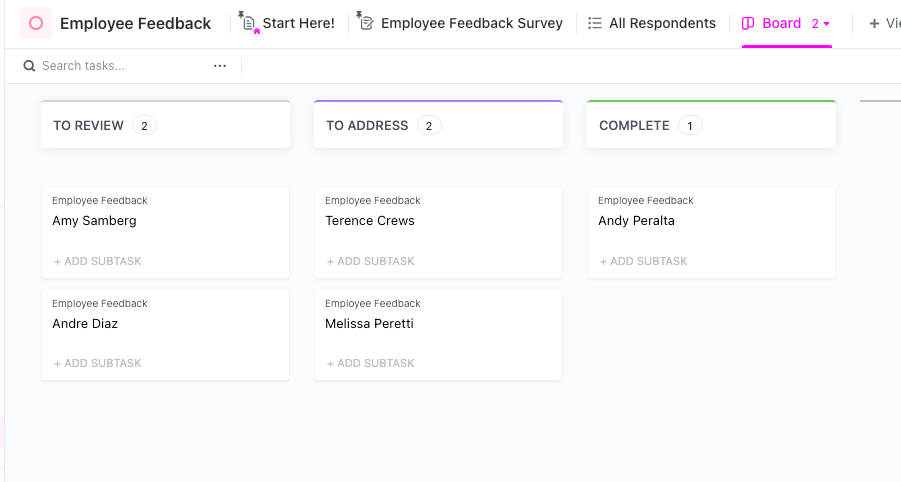
The point is that your goals affect your employees’ goals. A crucial leadership skill is understanding with the right structure, you can motivate your team and keep them engaged with their work.
Create a better work environment
Your work environment can make or break team morale. Setting goals supports your personal growth, but it also gives you the knowledge to build a better environment for everyone. Team members need constructive criticism, but it’s up to team leaders to know how to deliver it.
Maybe you want to start delegating tasks so you spend less time on low-value projects. Not only does this reduce your workload, but it also shows employees that you trust them to take care of business.
A goal like “Act on 80% of employee feedback” shows the team you take their constructive feedback seriously. You might even uncover issues you didn’t see before, which puts you in a better position to serve your team and create a better culture.
Over time, you’ll see greater confidence, a sense of ownership, and more motivation in your team.
Build relationships
Do your employees look forward to team meetings or do they internally roll their eyes every time they get a Zoom invite? Your employees don’t have to become best friends, but strong working relationships are a must-have for healthy teamwork and a productive environment. 🤝
Set leadership goals to improve your soft skills. When you’re better at communicating, resolving conflict, and practicing active listening, you’ll create the groundwork for better team relationships.
Set a positive example
Culture changes start from the top. If you want your team to be more independent and thorough, you’ll need to model that behavior first.
Humans are social creatures, so before you know it, your team will start mirroring your work style. It’s a smart way to put “monkey see, monkey do” to work for your team.
10 Leadership Goal Examples
Every manager is on a different journey, but we know it’s easier to set goals if you have a few SMART goal examples to pull from. Whether you’re setting project management goals or performance goals, check out these 10 leadership goal examples for a head start.
1. Schedule effective one-on-ones
Weekly check-ins are your opportunity to help employees. Unfortunately, too many managers are spread thin and these one-on-ones can run off the rails pretty quickly.
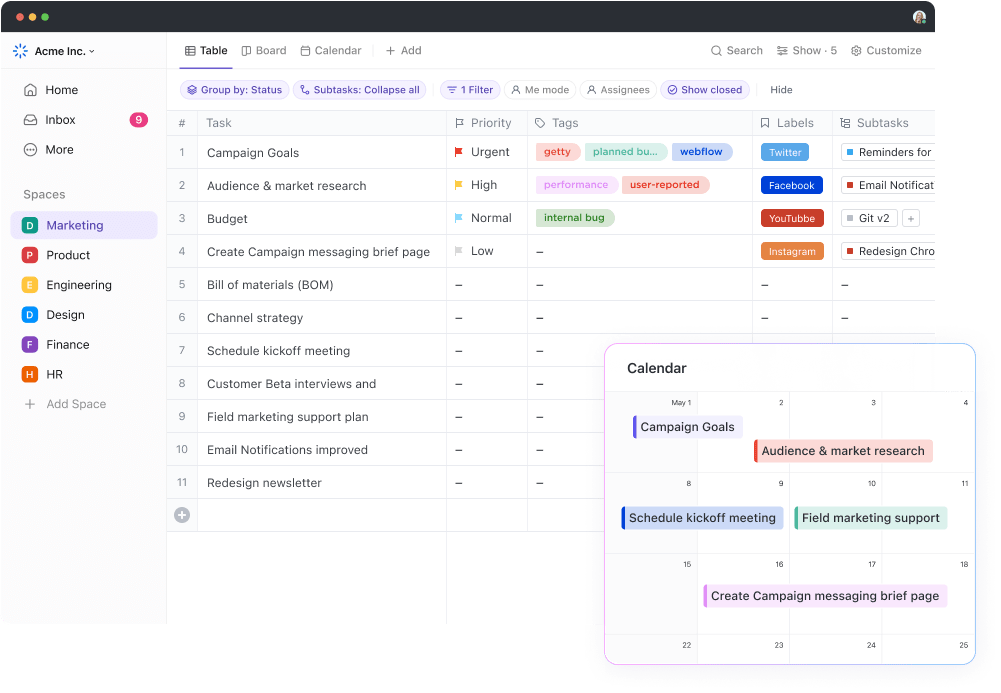
Clean things up and schedule more effective one-on-ones with your team. Use ClickUp’s Calendar view to schedule all of your check-ins and see your to-dos in one place.
It’s also a good idea to take notes at every check-in, so plug everything into ClickUp Docs. Create a folder for each team member and easily track their progress over time.
But don’t worry—you don’t need to spend hours formatting these Docs. Just pull up the ClickUp One-on-one Meeting Template, and you’re off to the races. 📚
2. Practice better time management

Is your to-do list growing by the minute? Time management won’t solve everything, but this leadership goal will certainly make you more efficient.
Make progress on this goal by:
- Using time blocking to maintain your focus throughout the day
- Delegating tasks to your team
- Bringing all of your tools into one platform with ClickUp integrations
- Creating trigger-based ClickUp Automations to streamline your workflow
- Staying on top of project timelines with time-saving ClickUp templates
3. Be more organized
Feeling overwhelmed by projects, to-dos, meetings, and emails? Set a leadership goal to become more organized.
The first step is to plug all of your tasks into ClickUp’s free project management software. From there, visualize all of your to-dos in a ClickUp Kanban board to get a high-level view of everything at once.
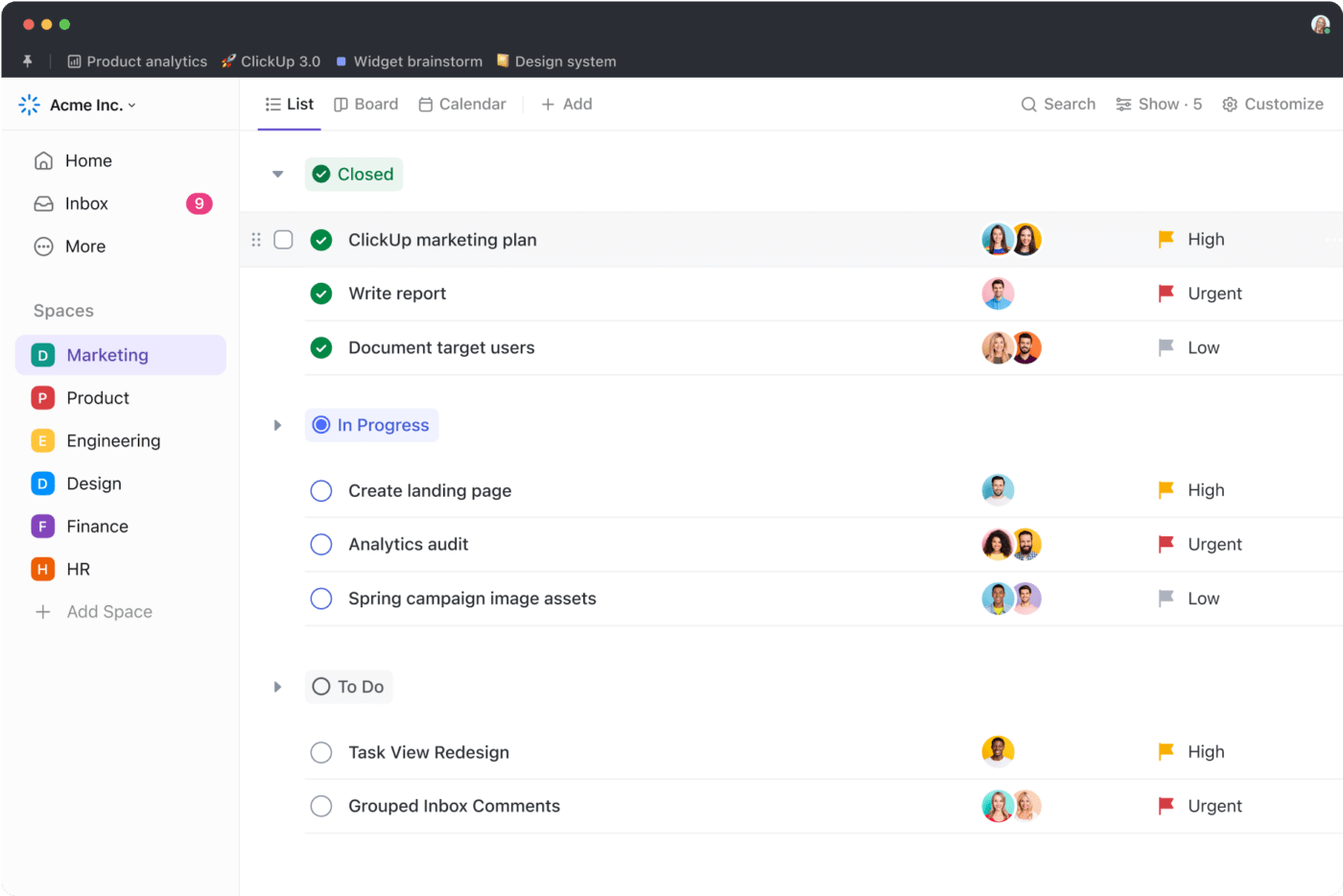
ClickUp brings all of your tasks, files, Chats, and Docs into one place, so no more rummaging around for messages or files—everything’s organized in one place for you.
4. Come up with innovative solutions
Leaders are responsible for innovation, but thinking outside of the box isn’t always a piece of cake. Setting this leadership goal generates more quality ideas for your business, but how do you become more innovative?
Brainstorm with your team members using a ClickUp Mind Map. Think of it as a collaborative problem-solving framework that logs all of your great ideas in real time.

Best of all, Mind Maps integrate with your goals and project management roadmaps, so acting on these big ideas is as easy as a single click.
5. Improve emotional intelligence
Hard skills are important, but soft skills matter a lot in the workplace. Set leadership goals for improving your active listening skills, open-mindedness, adaptability, and how you take constructive criticism.
Use ClickUp Form view to create employee feedback forms. Display this data in your ClickUp Dashboard to see how your team ranks your emotional intelligence. This will give you helpful, quantified data to improve your soft skills.
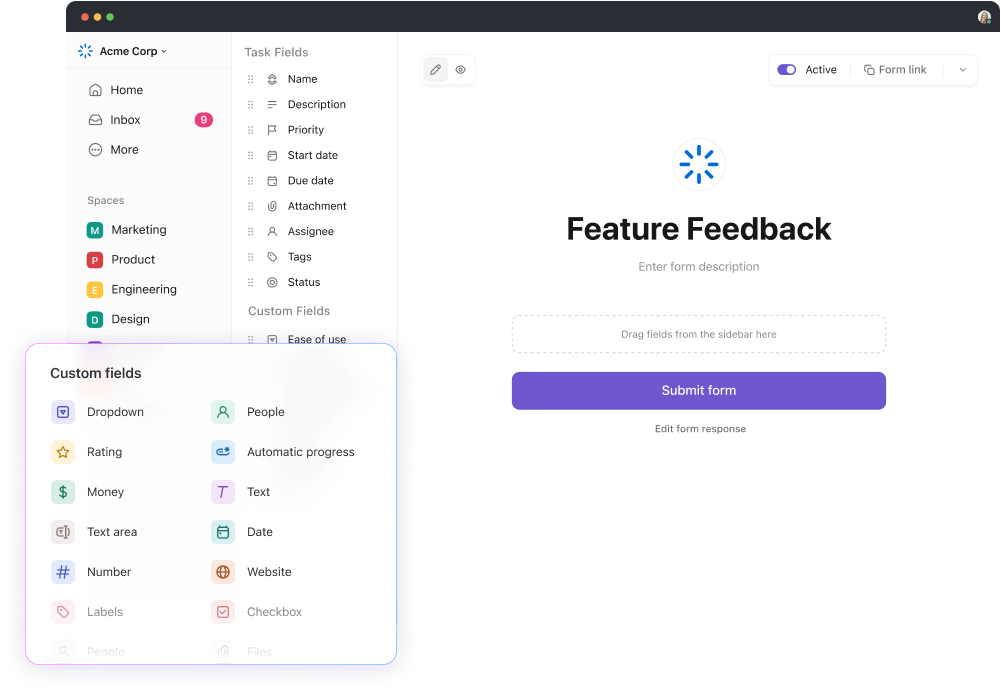
6. Boost team accountability
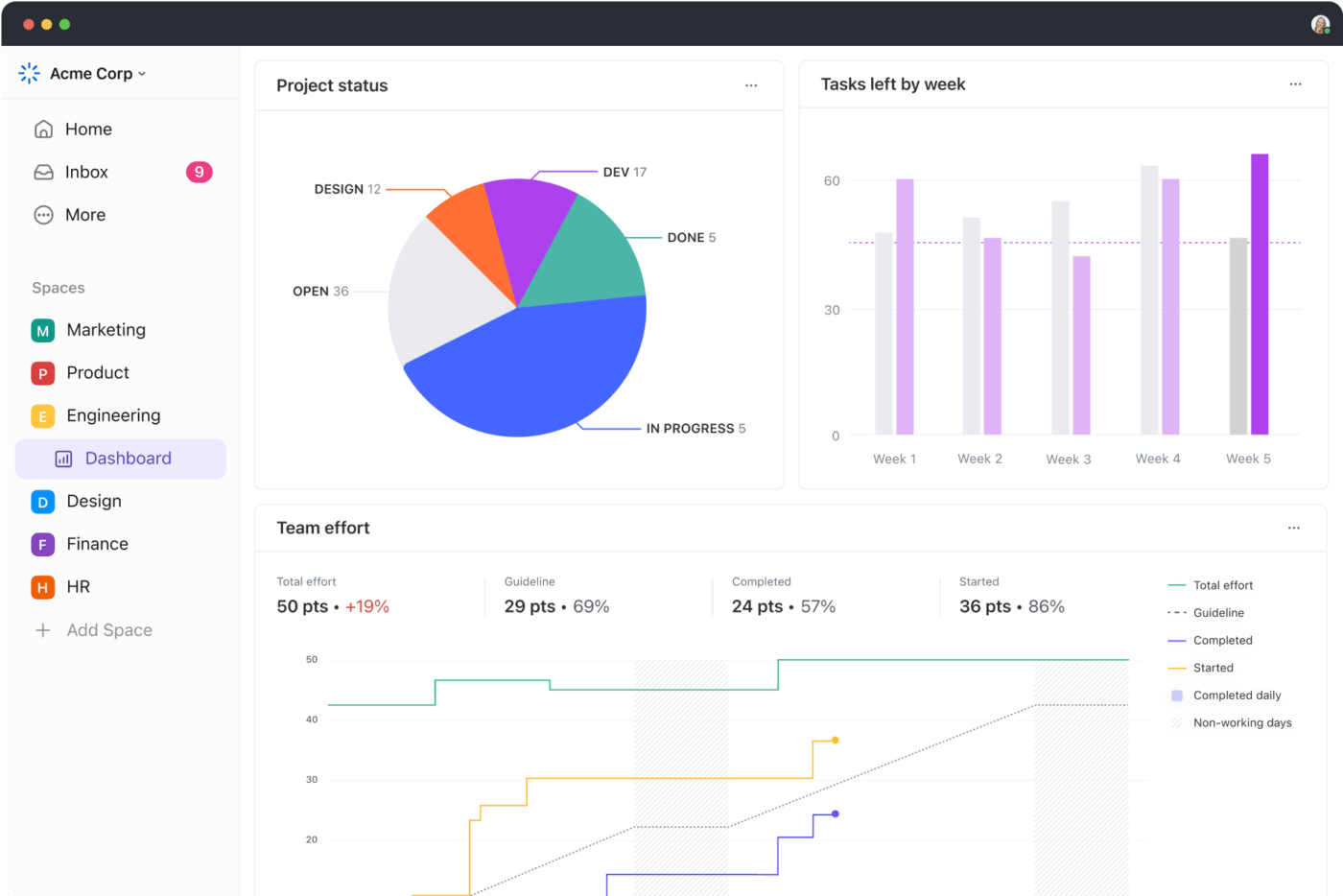
This leadership goal is a must for engaging and motivating your team. Set up a ClickUp Dashboard to track team goals. You’ll see everyone’s performance metrics and workload in one place, although you can use a goal-tracking app to display employee performance in real time, too.
7. Learn new skills
What hard skills do you need to be better at your job? Make a list of certifications, processes, or software you’re curious about. From there, give yourself a recurring ClickUp task in the Timeline view to hold yourself accountable.

This will help you set better timelines for your projects and truly know how long tasks take. Understanding project timelines is crucial when looking to improve your leadership skills.
8. Foster professional development on your team
This leadership goal focuses on your team’s development. During your one-on-ones, ask your employees to come up with a few SMART goals.
Work with your team to plug these goals into a project management tracking app like ClickUp and display everyone’s progress in real-time.
Remind yourself to check up on these SMART goals during every check-in. If they’re struggling, that’s your cue to offer resources, training, or help.
9. Give back
You have years of experience under your belt, but chances are, someone helped you get to where you are in your career. Why not return the favor?
Set a leadership goal for giving back in some way, whether that’s offering mentorship to someone interested in the field or offering free training.
10. Increase team morale
Does your team need a pick-me-up? Team morale is tricky, but achieving this leadership goal will reap dividends in terms of productivity and retention.
The best way to boost morale is to sit down with your team and figure out what they need. From there, you’ll probably need to create separate short-term goals for culture-building, process improvements, or software changes.
5 Templates to Achieve Leadership Goals
Setting goals is one thing—achieving them is another matter entirely. Whether you need help setting goals or monitoring them, these five templates offer a readymade structure for implementation and accountability.
1. ClickUp Leader Standard Work Template

The ClickUp Leader Standard Work Template makes it easy to log all of your team’s objectives, assess performance, and spot potential issues. Use it either for your personal leadership goals or your team’s goals.
Either way, it’s a smart method for organizing your objectives.
2. ClickUp Company OKRs and Goals Template
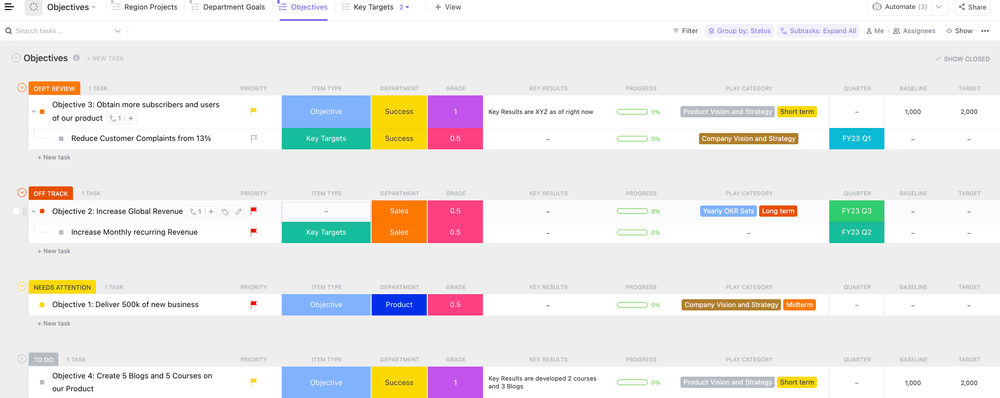
Objectives and key results (OKRs) are a type of hyper-structured goal. Tracking OKRs across an entire company sounds daunting, but the ClickUp Company OKRs and Goals Template makes it a breeze.
Use this template to align your team on objectives, prioritize goals by impact, and track everything automatically over time. You can also link this template to your ClickUp Goals for automatic progress tracking.
3. ClickUp Project Monitoring and Control Plan Template
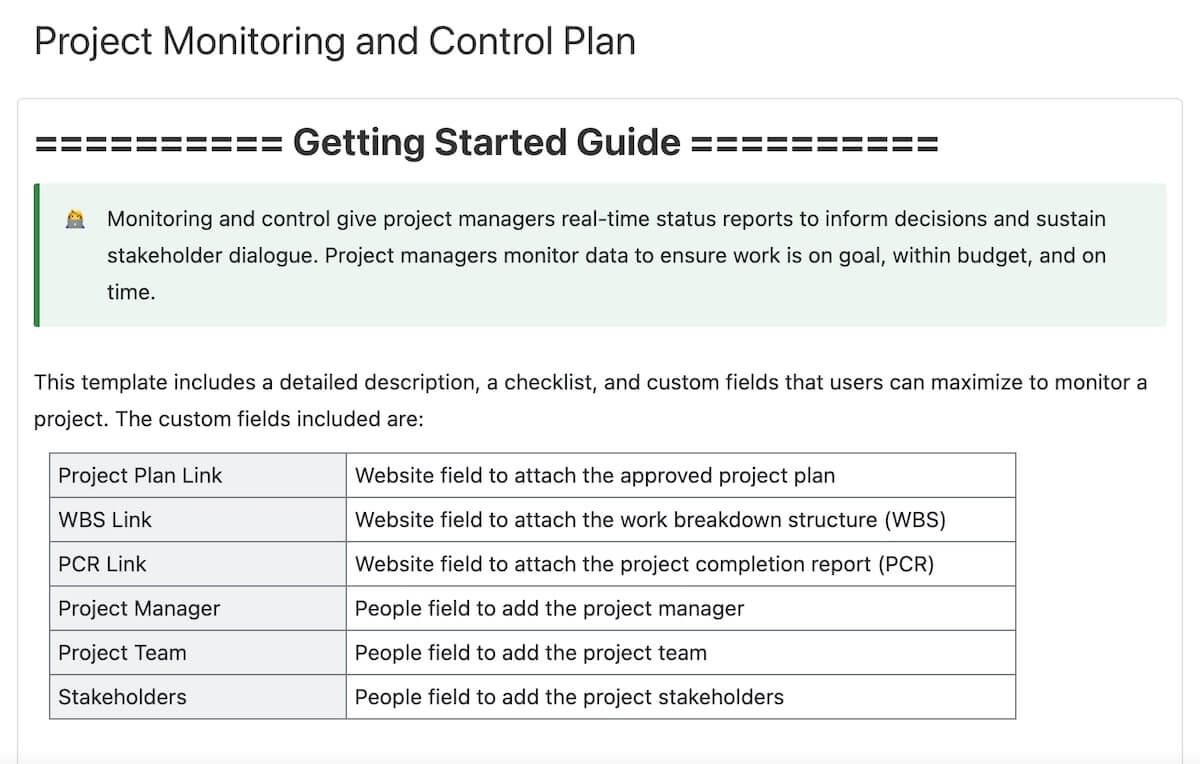
The Project Monitoring and Control Plan Template gives you an instant structure for managing a project’s timeline, budget, and deliverables. If your leadership goal is to streamline your team’s workflow or knock your clients’ socks off with a quality project, this template will get you across the finish line.
Easily outline stakeholders, contributors, and links to tasks or Spaces within the ClickUp Doc.
4. ClickUp Goals Signals Measures Template
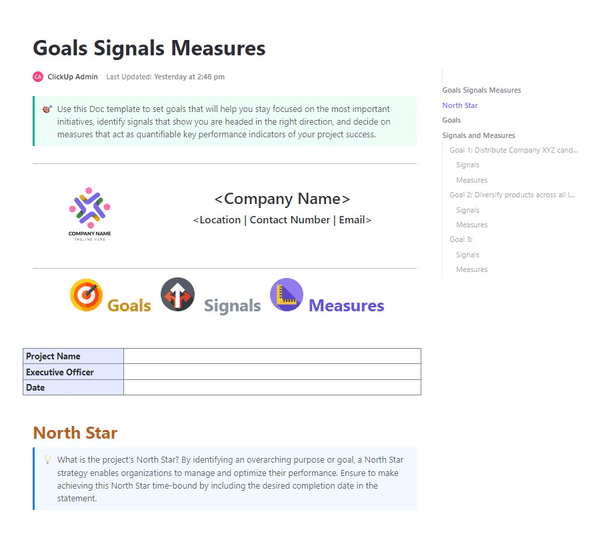
A Goals-Signals-Measures (GSM) framework tracks your team’s key performance indicators (KPIs) in one convenient place so you can view all performance data in the same dashboard.
The ClickUp Goals Signals Measures Template clearly defines success for you and your team and automatically tracks progress against your goals in real-time. Use this doc for constructive feedback and start building a more positive work environment for all.
5. ClickUp Leadership Team Health Monitor Template

Need to check the status of your leadership efforts? The ClickUp Leadership Team Health Monitor Template plugs each manager’s performance stats into a tracker to look at real-time growth metrics.
The template identifies areas for improvement, which makes it the perfect tool for setting leadership goals.
Start Setting Leadership Development Goals in ClickUp
It isn’t easy developing your leadership skills, but the right goals will boost your management skills in no time. Of course, you still need a development plan and a platform to track all of your progress, and that’s where we come in!
ClickUp combines your tasks, Docs, Mind Maps, and templates into one platform to save time and streamline your workflows. Oh, and did we mention it’s Free Forever?
Create a ClickUp Workspace now to try it for yourself—no credit card required.



